UPDATED: October 16, 2022
You’re brushing your teeth in the morning and you notice a small piece of dirt coming out of your water faucet. You almost put that in your mouth, YUCK! But you have a water softener, so how did that piece of dirt get to your bathroom sink? Do I need a pre-filter for my water softener?
You may need a water pre-filter for your water softener to remove sediment coming in from your water supply, to remove chlorine from municipal water, or your water has an odd taste or smell to it.
If you get your water from your own private well, there is likely a little bit of sediment being brought up from the well with your water. Even municipal water can have sediment and other impurities in it. So do you need a water pre-filter, and what kind of pre-filter do you need?
Here’s What We Will Be Covering:
- What is in your water that should be removed with a prefilter
- Types of water prefilters and what they filter out of your water
- How a prefilter can improve your water
- How a prefilter can protect your water softener
- What size water prefilter do you need?
What is in your water that should be removed with a pre-filter?
There are various water filter cartridges that you can use to remove impurities from the water that you don’t want in your water and could harm your water softener.
In order to determine what is in your water, you should do a visual inspection of your water in addition to testing your water for impurities like sediment, iron, and chlorine that can easily be removed from your water by using the correct water prefilter cartridge.
Types of water pre-filters and what they filter out of your water
| Filter Type | Removes | Commonly Used For | Water Source | Common Diameters | Common Lengths |
|---|---|---|---|---|---|
| Sediment | Medium To Large Sediment | Dirt/Debris | Well/Municipal | 2.5″/4.5″ | 10″/20″ |
| Spun-Polypropylene | Fine Particles | Iron/ Clay | Well/Municipal | 2.5″/4.5″ | 10″/20″ |
| Granular Activated Carbon (GAC) | Dissolved Gasses/ Fine Particles | Chlorine/Chemicals/Odor* | Well/Municipal | 2.5″/4.5″ | 10″/20″ |
| Carbon Block | Dissolved Gasses/ Fine Particles | Chlorine/Chemicals/Odor** | Well/Municipal | 2.5″/4.5″ | 10″/20″ |
Why you might need a sediment pre-filter before your water softener.
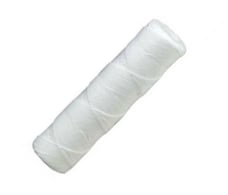
If you have ever noticed little specs of dirt or other sediment coming out of your water faucet or experienced any odd tastes in your water, a pre-filter would help to capture any sediment including tiny particles that may cause your water to have an odd taste.
Although a standard pre-filter will not reduce the amount of sodium or other dissolved solids in your water as a reverse osmosis system would, there are many non-dissolved particles that can be found in water that can be removed with a simple water pre-filter.
Common Types Of Sediment Filters And How They Can Benefit You.
| Sediment Filters | Benefits | Disadvantages | Commonly Used For |
|---|---|---|---|
| Pleated Cellulose | Inexpensive/Fewer Filter Changes | Paper/ Not Recommended To Reuse | Medium/Large Sediment |
| Pleated Polyester | Inexpensive/Fewer Filter Changes | Polyester/ Can Be Reused Several Times | Medium/Large Sediment |
| String-Wound | Inexpensive/More Frequent Filter Changes | Fiber/ Not Recommended To Reuse | Medium/Large Sediment |
| Spun-Polypropylene | Medium Price/More Frequent Filter Changes | Polypropylene/ Not Recommended To Reuse | Fine/Medium Sediment |
| Dual-Gradient | Medium Price/More Frequent Filter Changes | Polypropylene/ Not Recommended To Reuse | Fine/Medium Sediment |
A pre-filter can also do a great job of removing iron from your water.
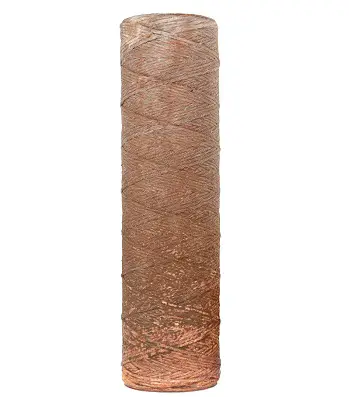
If iron is an issue in your water, the combination of a water softener and a pre-filter is a great way to eliminate iron from your water because the combination of the two can remove both dissolved iron (Ferrous), and non-dissolved iron (Ferric).
A water softener can remove small to moderate levels of non-dissolved iron that may be in your water, and a pre-filter with a 5-micron filter cartridge can do a great job at removing non-dissolved iron from your water.
Although most water filter cartridges that are used as a pre-filter are not fine enough to capture non-dissolved iron in the water, a 5-micron pre-filter cartridge is fine enough to capture iron particles, yet not so fine that it will significantly affect your water pressure.
When you do notice a drop in water pressure, that will tell you when the filter needs to be changed, a small price to pay to have iron-free water in my opinion.
Cloudy water from clay may become clear with the right pre-filter.
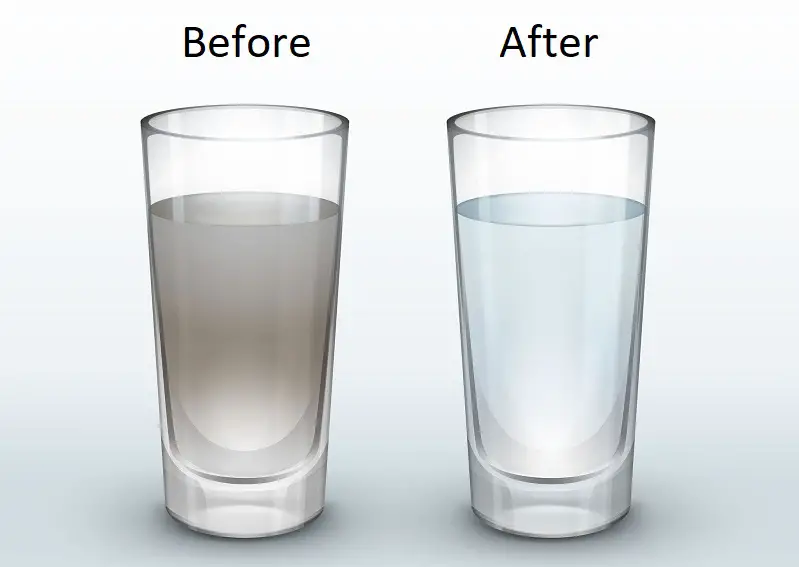
Clay can be a tricky thing to remove from your water, and a water pre-filter may not be enough to do the job in your situation. But if you are noticing slight cloudiness in your water that doesn’t seem to go away, a water pre-filter may be able to help.
For clay removal, you will need to use a 5-micron or lower-micron filter cartridge to filter out the clay but I recommend starting with a 5-micron filter cartridge first, and then trying a 1-micron if needed to limit any drop in water pressure.
Because clay is such a fine particle, the finer the filter cartridge, the quicker it will get clogged. So why use a filter that will clog up quicker if you don’t have to?
A carbon pre-filter can improve the taste of your water and remove odors.
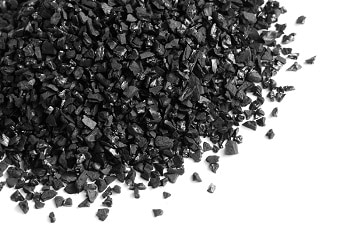
A water softener is used to remove minerals from water that make the water less effective with soap and detergents for cleaning, but it is not intended for the reduction of odors in your water.
For chlorine, sulfur, and other mild odors that may be found in your water, a pre-filter containing carbon is used for its ability to remove the small particles that commonly cause odors in the water.(source)
This type of water pre-filter is important to have before your water softener to remove chlorine which will damage the water-softening resin over time.
Chlorine can cause the water-softening resin to swell and lose its effectiveness to remove hard minerals from the water.
See my article “Can Water Softener Resin Go Bad?” for more details about how chlorine can affect your water softeners resin.
Paul Burkhardt
So if you have municipal water, it is very likely treated with chlorine to make it safe for drinking and you should consider having a carbon pre-filter before your water softener to protect the water-softening resin from damage.
Common Types Of Carbon Filters And How They Can Benefit You.
| Type Of Carbon Filter | Benefits | Disadvantages | Commonly Used For |
|---|---|---|---|
| Carbon Block | Firmly Packed Carbon For More Filtering | Restricted Water Flow | Municipal Water |
| Granular Activated Carbon (GAC) | Loose Carbon For Better Water Flow | More Frequent Filter Changes | Well Water |
A Prefilter will protect your water softener from accelerated wear and tear.
A little piece of dirt or grit may not seem like a big issue but for every tiny spec of grit that you happen to see, there are plenty more that you don’t see.
Before those particles make it to your kitchen faucet, they have to go through your water softener, and as they do, they can be wearing away at the internal workings of your water softener that make the system work properly.
Because a water softener is naturally controlling water flow through it, it has to use watertight seals to control how the water flows through the system.
If grit gets caught between these seals, it can cause small scratches which slowly get bigger, and eventually, those watertight seals are no longer watertight.
If the seals don’t stop water flow, your water softener will not function correctly and your water softener could leak water down the drain twenty-four hours a day.
And if your water softener is non-electric, that means that it operates with tiny gears and impellers that can easily jam and stick when even one tiny spec of grit gets stuck in them. This can cause them not to register water usage and can cause them to run constantly.
Whatever the reason that it will benefit your water softener, do you really want dirt and sediment in your water when you can have perfectly clear water just by using a water-sediment pre-filter, I know I don’t!
A water softener is not intended to filter water at all.
Many people have been misled into thinking that a water softener will not only make your water soft but will filter out particles as well.
Actually, a water filter will do very little to remove any sediment from your water.
Most sediment particles are fine enough to work their way through a water softener softening resin and will come out the other end eventually.
See my article “Does a water softener filter water” for more details!
This is why a pre-filter is so commonly used along with a water softener.
A calcite acid neutralizer also works as a sediment pre-filter.
If you have highly acidic water, you may already have a sediment pre-filter, but it may be called an acid-neutralizing filter.
It is commonly a tall tank that is installed before your water softener and often has a capped port towards the top of it to replenish the acid-neutralizing calcite that slowly dissolves over time.
Calcite is great at neutralizing acid, it is the primary ingredient in most tablets that you might take when you have heartburn. But it is the fine, sand-like size of its grains that make it an effective backwashing sediment filter in many cases.
Most of the time, the water will be running down over the calcite and then out to your water softener. As the water flows through the calcite, sediment can be captured on the top. Then, every few days the system will perform a backwash.
When the system backwashes, the water goes in the opposite direction, pushing the captured sediment up and out of the system where it gets rinsed down the drain. So it is essentially a backwashing sediment filter for larger-sized sediment particles.
When you might need a larger pre-filter before your water softener.
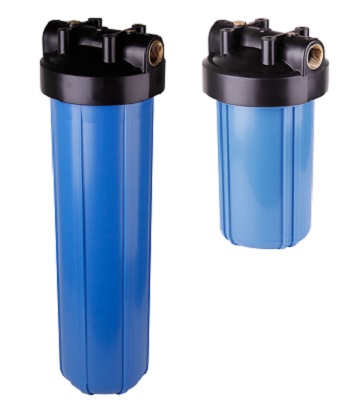
If you have a high amount of sediment coming in with your water, you use a large amount of water in your home, or just don’t want to have to change a filter as often as you would have to with a standard-sized water pre-filter, a large water pre-filter may be a better fit.
The most common water filter housing uses a 2.5-inch diameter by 9 3/4 – 10-inch long water filter cartridge but they are also available in a larger 4.5-inch diameter by 10 or even 20-inch long filter cartridge.
This larger size whole house filter may be beneficial where more sediment needs to be filtered or when higher volumes of water are used because they provide a more usable filtering surface area. They can also be handy if you simply don’t want to change the filter as often.
What if you don’t want to have to change a pre-filter?
If your sediment situation is light to moderate, you may be interested in a backwashing sediment filter that will filter out the sediment in your water and then backwash it away without the need of changing any filters at all.
A backwashing water prefilter operates and looks very much like a water softener but with the sole purpose of filtering sediment from your water.
Why you may want a post-filter after your water softener.
Occasionally, you may want a filter after your water softener if you already have a pre-filter that handles most of your sediment problem but sometimes some sediment gets past it.
When a filter is installed after a water softener, it is often called a polishing filter as it is just to give the water one last “touch-up” filtering to make sure that it is the best that it can be.
This would also apply to carbon filters for chemicals and odors.
Another example of a post-filter would be when people find that they occasionally run into hard water due to a spike in water usage, and install a water-softening shower head to provide soft water, even when the water softener is not sufficiently softening the water.


